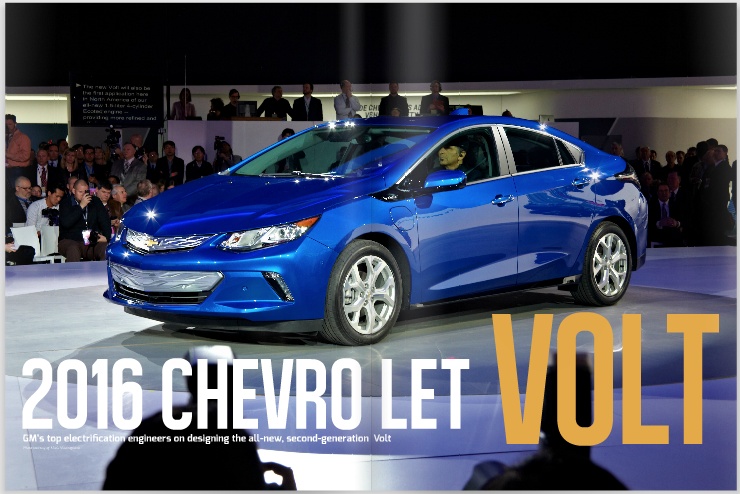When the Chevrolet Volt was launched at the end of 2010, I must confess that I gave it little chance of success. It seemed like an awkward compromise – buyers who wanted to go electric would surely prefer a pure EV, and buyers who weren’t ready to take that plunge had every reason to stick with a hybrid like the Toyota Prius, which cost far less than the Volt and had comparable gas mileage. I also thought GM’s designation of the Volt as an Extended Range Electric Vehicle (EREV) was a presumptuous marketing gimmick – why not just call it a plug-in hybrid (PHEV)?
Well, I was completely and indisputably wrong. Five model years later, over 93,000 buyers have chosen the Volt (and its European twin, the Ampera), making it the second-best selling plug-in vehicle in the world, after the Nissan LEAF (which has sold over 177,000 worldwide). Buyer satisfaction ratings are sky-high. And, in the light of real-world driving behavior, the Volt really is a different animal from other PHEVs, so coining a new category for it no longer seems unreasonable.
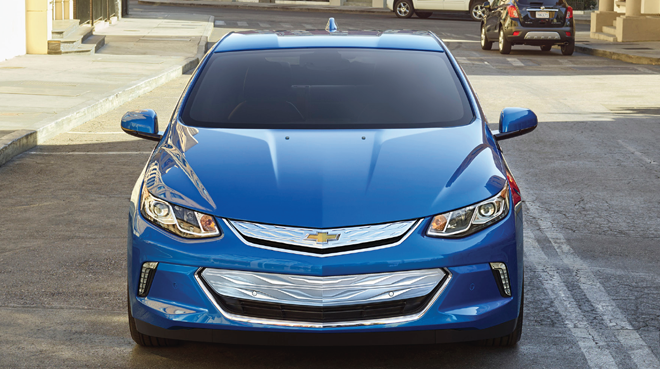

The second-generation Volt, which will go on sale in the US this fall, is not just an incremental improvement. GM took the vehicle apart and redesigned it from the ground up, guided by the huge amount of knowledge and data, including customer feedback, gained from the first-generation Volt.
Perhaps the most important thing GM learned from its intense analysis of vehicle data was that drivers think of their Volt as an EV. By June 2014, Volts had logged more than half a billion miles in North America, and 63% of those miles were driven in EV mode. The top improvement drivers asked for was increased electric range. They also wanted improved performance, with power on demand regardless of whether the vehicle is operating in electric or range-extended mode.
GM took a blank-sheet approach to designing the second-generation system. An R&D team examined more than 50 types of electric and hybrid propulsion systems, and used proprietary simulation software to conduct extensive modeling, before developing the latest Voltec powertrain.
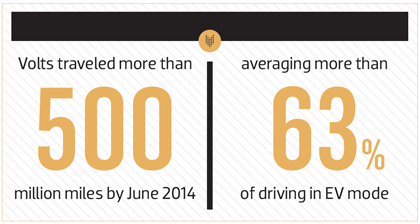

The new system is fundamentally different, with two electric motors and a larger gas engine, that work together in new ways to maximize efficiency. There are also dozens of smaller improvements, including upgrades to the power electronics and on-board charger, as well as more integration of components. All contribute to more range, better performance and lower cost.
GM engineers revealed a wealth of details on the technology of the second-generation Voltec propulsion system in a set of five papers presented to the SAE (which are available to the public on the SAE website). To get the stories behind the facts and figures, Charged spoke with Andrew Farah, 2016 Volt Chief Engineer, and Larry Nitz, head of Hybrid and Electric Powertrain Engineering.
More range, lighter pack
At the top of the list of improvements is a better battery. The Volt’s lithium-ion battery pack has been completely redesigned, and its capacity increased from 17.1 kWh to 18.4 kWh. EPA testing has confirmed the Volt’s greatly increased range: 53 miles, compared to 38 miles for the outgoing model. Fuel efficiency is rated at 106 mpge, and 42 mpg when running on gasoline alone.
The new battery pack looks pretty much the same as the old, but inside, it has been completely redesigned.
Andrew Farah: It’s still a T-shaped battery pack that’s loaded from the bottom and goes down the middle of the car and underneath the rear seats. The new generation is similar in volume and general dimensions, but it’s about 20 pounds lighter than the gen-1 pack, and it has a little bit lower profile. Reworking the general size of the cells allowed us to have a car that has a little bit more internal room. The system is still liquid-cooled, just like gen 1.


Larry Nitz: If you put the two battery packs next to each other from 100 feet away you couldn’t tell the difference. But when you get up close, every single part inside the battery pack has changed.
The first-gen Volt had three 15.5 Ah cells in parallel, and then 93 sets of those three in series, for a total of 388 cells in the pack. Each cell touches a cooling fin, and each cell touches a foam compression device that allows the cells to operate with face pressure for technical reasons like charging and discharging stability.
The second gen is similar, but uses two 26 Ah cells in parallel. The pairs of two are put 96 in series. It has the same voltage overall, but only 192 cells in the pack. That means the number of cooling fins is reduced, the number of separators is reduced, and the number of modules to connect them is reduced. So we’ve packed more energy inside the pack through cell optimization and reduction of the overhead parts. This allows the pack to be lighter and yet more energy-dense, which helps us get additional range.
The new battery pack also uses a larger envelope of available power.
Larry: In the first-gen Volt we used about 110 kW. In the second-gen Volt we’re using about 120 kW. So you have a little more power, but when you drive the second-gen Volt, the thing that you feel is the 20% increase in low-speed launch characteristics, from basically a 0.4 g to about a 0.5 g launch, and you can really feel that difference.
Andrew: We’ve also done overall lightweighting, so when you combine that improved power coming out of the tractive effort with the overall weight reduction, it really makes a difference in what the customer feels when they’re sitting behind the wheel.
Two motors are better
The first-generation Voltec drive system used a 111 kW main traction motor and a 55 kW generator motor. In the second-generation system, two smaller motors share both roles, and there is a larger gas engine that’s clutched to the drivetrain more often than in the first generation.
The split of EV propulsion between the two motors allows the gas engine to be started using torque from an electronically-controlled motor, making the starts smoother, quieter, and more efficient than using a slipping clutch or a conventional starter. It also eliminates a certain amount of hardware that isn’t needed for electric driving.
The paired motors operate in two electric driving modes to increase efficiency. Two-motor mode provides peak torque at low speed, while one-motor mode kicks in under low-torque conditions, such as cruising down the highway.
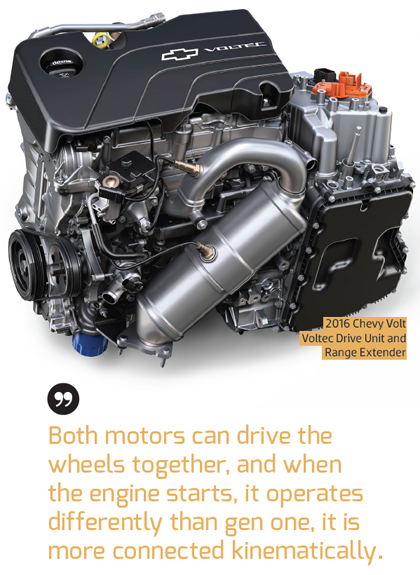

Because both motors can propel the vehicle, GM engineers were able to reduce the torque and power requirements for each motor, so the motors and their bearings could be substantially reduced in size, while actually improving performance. Compared to gen 1, the gen-2 motor system is 20% smaller and 40% lighter. At the same time, performance at low speeds (0-30 mph) has been improved by about 20%, with an overall improvement of about 7% from 0-60 mph.
Larry: In the first-gen Volt we had a large motor that basically provided all the driving tractive effort for the most part. The other motor was mostly used as a generator with the engine. In the second-gen Volt, we were able to reduce the overall size of the two of them and yet improve performance. Both motors can drive the wheels together, and when the engine starts, it operates differently than gen one, it is more connected kinematically. But from a customer perspective, it behaves very similar to the first-gen Volt in its electric drive character. The engine is larger and more powerful, and that is useful not only for efficiency, but also noise and vibration. We can keep the engine more in the background than we could in the first-gen Volt. Overall it’s better in multiple ways. More efficient, more powerful, quieter, and it uses regular fuel – the first-gen used premium fuel.
Earth, rare
Most EV traction motors depend on rare earth (RE) elements – costly materials prized for their magnetic properties. In the new Volt, GM engineers found ways to greatly reduce the amount of RE materials used.
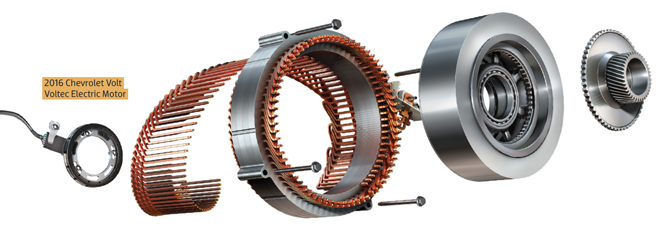

Larry Nitz: We can’t really control the price of these REs, and I’m not sure they’re really market-priced anyway because they’re largely controlled by a Chinese monopoly. So we wanted to reduce the amount of dependency. There are two different kinds of REs. There is the lighter kind we use in consumer goods like ear buds and a lot of other devices. They work great. They have great magnetic characteristics, but they don’t operate very well at higher temperatures like those seen in automobiles. Then we have the heavier REs, like dysprosium. It’s very expensive and it has better temperature characteristics.
Our objective in the gen-2 Volt was to become less dependent, especially on the heavier REs that can only be commercially found in China. So we use a mix of the light and heavy, reducing the amount of heavy REs (such as dysprosium and terbium) by 80% – using only one-fifth the amount – and a 50% reduction overall in the lighter rare earths such as neodymium and praseodymium.
Also, one of the motors uses no RE magnets at all. We were able to do that by using a ferrite magnet, which has less magnetic strength. When you create an electric motor, some of the torque comes from the magnets themselves and some of the torque comes from the geometry of the field that is formed in the motor – we call that reluctance torque. We were able to use both the ferrite magnets and the reluctance torque to make that motor do what it needs to do.
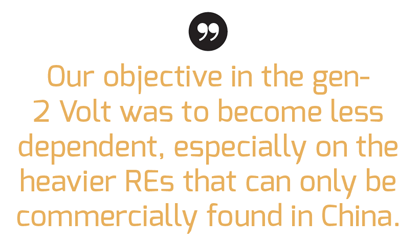

It’s a good tradeoff between the two. The ferrite magnet motor has a little bit less torque needed in it, so we were able to do it with these less expensive magnetics. Ferrite magnet motors have very good high-temperature magnetism characteristics. Their challenge is actually demagnetizing at low temperature, not high. Neodymium magnets want to demagnetize at higher temps. So, it’s a different kind of problem that we had to solve. It’s lower cost, but certainly there is more design complexity to doing a ferrite motor. I think we’re the first OEM to bring out a traction motor of any kind that uses ferrite magnets. We feel pretty good about leading the industry away from a commodity that’s subject to price fluctuations.
Bigger engine, slimmer packaging
It may seem counterintuitive, but the new Volt’s 1.5-liter four-cylinder gas engine is larger than in the previous model. As GM explained in its SAE presentation, “Operation of a range extender differs from that of a typical hybrid or conventional engine in that the level of available battery power allows considerably more flexibility [and] allows the system to operate the engine closer to peak efficiency points. While it may seem at first glance that the ideal choice for engine efficiency would be to minimize displacement…it was actually found that a larger normally aspirated engine provided advantages in both efficiency and EV drive character.”


Other advances have to do with packaging: integration of components and design improvements that reduce the amount of connectors can save on volume, weight and costs, especially in the power electronics.
Larry: If you open the hood of the first-gen Volt, you’ll see orange cables all over the place. And those cables are highly engineered. They’re complicated. They’re not inexpensive. And they weigh a lot – they’re full of copper and other shielding materials. We decided to attach the electronics directly in a cavity on the transmission – almost, if you will, in the drive unit. It eliminated those three-phase cables completely by connecting the motors through connection studs down into the drive system.
This has been done in electric vehicles, but it is not commonly done in vehicles with an engine attached that has engine vibration inputs. The challenge there is to harden the electronics to the vibrations that you would see in a powertrain-mounted configuration. Some of our competitors have used rubberized mounts and shock absorbers – not as efficient a mounting setup as being able to harden the electronics to the vibration. We have a structural mount of the electronics right to the drive unit itself and the bolting down of that – the sandwich construction of the electronics – is very robust in the direction of highest vibration.
It saves a lot of complex routing of those big orange three-phase cables. It saves the connectors. It saves the shielding. It saves the interface. It saves a lot of complexity.


You basically have to beef up, or smartly engineer, the structure of the electronics and the mounting interfaces of the electronics to the powertrain, so that we don’t have a nodal point where the electronics attach. It took a lot of finite-element work, a lot of testing to correlate the models and the math back to the parts themselves. And then testing, testing, testing, to make sure that we had a robust connection.
Another story to be told about the next generation Volt is its higher proportion of US-made components.
Larry: We’ve gone from about 50% North American content to over 70% North American content – and a lot of that content has also gone from Mexico back to the US. The electronic modules, for example, are now made in Indiana versus Japan. The electric motors are now made in Kentucky versus Japan. The final assembly of the drive system is done in Warren, Michigan versus Mexico. These electronics assemblies are very hands-off type of assembly, with a lot of automation, so we can cost-effectively do them in the US.
GM chose to modularize the Voltec powertrain so that it can be mated with different engines and used in a hybrid or an extended-range EV with minimal changes to the electric drive. This strategy lowers GM’s investment, and increases scale for it and its suppliers, making the whole electrification proposition more cost-effective.


The 2016 Chevrolet Malibu will be offered in a hybrid version that shares most of its powertrain with the 2016 Volt. One major difference however, is the battery, which has a rather different job to do in a hybrid, as opposed to an EREV.
Larry: The Malibu hybrid also uses lithium-ion, but it’s a power battery and completely different than the Volt battery, which is an energy battery. The power battery is about 1.5 kWh, versus 18.4 kWh in the Volt. It’s a very different formula.
The Malibu cells are from Hitachi [and the Volt cells are from LG Chem]. Both battery packs are designed and built by GM. We have a strategy to buy cells and largely make our own packs. The Malibu hybrid is actually the first power battery pack that we’ve produced.
On the Malibu hybrid we have a larger and more powerful engine, because we don’t have the really big battery. It delivers less than one-third the power that the Volt battery can deliver. Inside the electric drive unit, about half a dozen parts are changed, including one of the motors, which is optimized differently for a hybrid.
The Malibu Hybrid will get 47 mpg combined – if that’s not the best, it’s right up there with the best D-segment hybrid in the world. We can do it with this same electric drive system. Most of our competitors would have something more dedicated for that size vehicle.
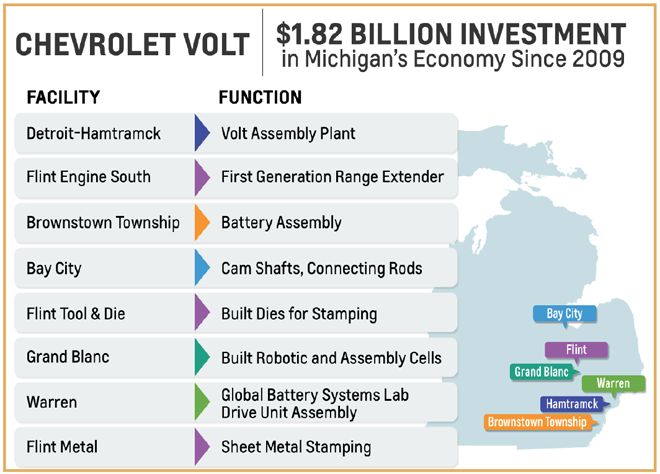

Driving and learning
The 2014 Cadillac ELR is a good example of how the study of advanced electric powertrains leads to better vehicles. The low-volume luxury model debuted using exactly the same hardware as the first-gen Volt, but offered more power from the same components. GM’s engineers attribute the power gains to new software and a better understanding of the powertrain’s limits in the real world.
Larry: The ELR’s performance was improved through better understanding of what that cell chemistry can actually do. We had conservative sizing of some of the components – a lot of them are sized for worst-case temperature conditions.
In the next-gen Volt, we took all that learning and re-optimized everything to reduce mass, size, and cost. For example, the electric drive system, which includes the motors, gearing, drive unit and the electronics, is 100 pounds lighter. It’s smaller, it’s more efficient.
We learned how far we could push some of these components. There were things that we didn’t know when we started off on the first-gen Volt and now we know very well. And there were things that we theorized about in the first-gen Volt that turned out to be true, so we continued them in the second gen. For example, the liquid-cooled battery – every cell touches an active cooling plate, and that has been key to the first-gen Volt’s battery pack reliability and performance. We’re thrilled with that configuration, so we’ve kept that, optimized it and improved it, but essentially kept that for the second-gen Volt.
Andrew: With the ELR, we were able to use the gen-1 Voltec parts and components, to create a vehicle that had more performance. With the gen-2 Volt, what we really went after is more range as opposed to more acceleration. We actually got both, but we were really focused on trying to get to that 50-mile number.
We’ve learned where we can stress our components a little more appropriately and get more performance, whether that be acceleration or range or both. We’re continuing to move down that learning curve.


Data on real-world usage also inspired improvements to the Volt’s on-board charger.
Larry: We’ve learned a lot about charging behaviors and chargers. The charger on the next-gen Volt is 8-10% more efficient. That means that more of the power that you’re taking from the wall goes to charge the battery. The charge times are almost the same as the first-gen Volt even though we store more energy, because the charger is slightly larger and more efficient. The magnetic circuit inside the charger is a point of great development over the last five years, and now delivers really high-efficiency charging – over 90% efficient.
As early adopters of a revolutionary new technology, Volt owners are an invaluable resource that GM continues to take advantage of to guide the vehicle’s development.
Andrew: Every single one of these technical upgrades had to turn into a customer benefit. We’re very careful to make sure that we’re not just working on technology for technology’s sake. We’ve got a great group of about 77,000 owners out in the field right now with the gen-1 vehicle. They’re very vocal about what they like and they’re also not shy about things they would like to see improved. We’ve been listening very carefully to both of those messages and we think we’re going to deliver on both.
They wanted more electric range and we’ve given them more. They really enjoyed how fun to drive the vehicle is and I think we’ve achieved that in the way that the car handles – it’s more sporty, more nimble. And they also wanted it to be more efficient overall. With the increased range and increased fuel economy of over 40 mpg, we’re able to offer exactly what they’re looking for.
Larry: This is a journey, and we’re just at the very beginning. What’s super-encouraging to us who work on this is that our customers love it. You can look at independent surveys and see all the awards, and when we talk to our customers, they love their automobiles. We’re going to deliver even better for them and also make the car more appealing to a broader base of customers in the future.
This article originally appeared in Charged Issue 20 – July/August 2015. Subscribe now!




